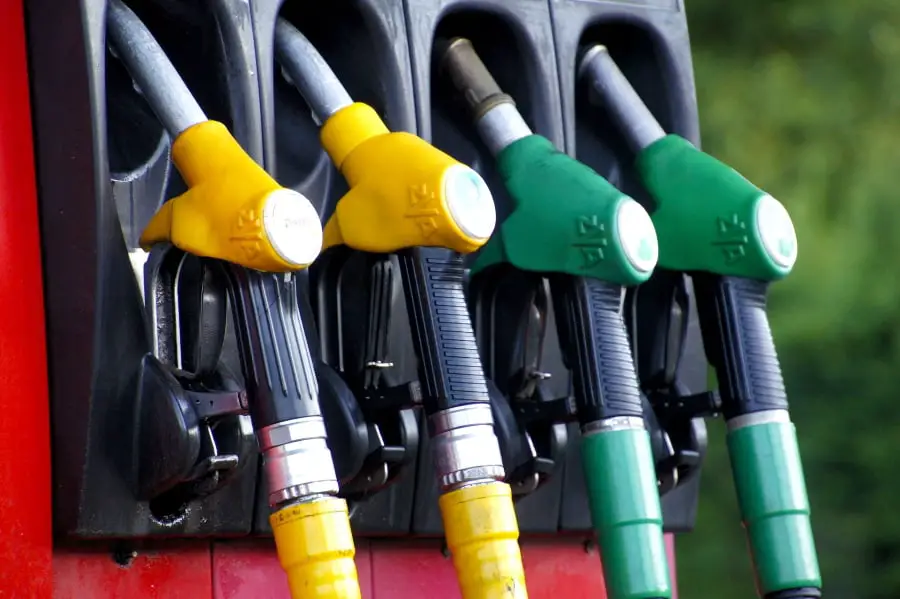Fueling your lawnmower should be a straightforward process but, as we know, mistakes happen. For whatever reason, you may find yourself putting the wrong fuel in the machine, which certainly sounds worrying.
The wrong fuel in a gas tank can cause serious harm to the engine in come instances. Gasoline in a Diesel engine can cause the most problems. All issues can be fixed with any fuel type by stopping the mower and letting it cool and using a siphon pump to drain the fuel tank.
Lucky for you, I’m here to help. Our first step is finding out exactly what happens when to a lawnmower if one attempts to run in with the wrong kind of fuel. I then look at other interesting facts around this topic before finally addressing the small matter of fixing the problem.

Contents
I Put The Wrong Fuel In My Lawn Mower
Maybe someone in your family accidentally used the “gas” canister to help kickstart a diesel truck and forgot to tell you there was diesel in it.
Maybe you borrowed what you thought was your buddy’s gasoline mower, when it was, in fact, a diesel mower. Uh-oh.
But how bad is the damage?
First, we need to establish what the wrong fuel is. Is it gasoline in a diesel lawnmower?
Diesel in a gasoline mower?
Diesel/gas in an oil-and-gas motor???
What Happens When You Use The Wrong Fuel In Mowers?
The realization that you’ve poured the wrong fuel in your (or worse…a borrowed) lawnmower may be quite horrifying but there’s no need to worry…too much.
Putting Diesel In A Gas Powered Mower
If like one of the examples above, you’re dealing with diesel in a gas motor, you’ll be pleased to know that the lawnmower will not suffer any damage, especially if it’s a one-off occurrence. The mower will not start until the diesel is replaced with gasoline.
Putting Gasoline In A Diesel Powered Lawn Mower
You will not be pleased to know that putting gasoline in a diesel engine is very bad. Gasoline harms the engine by forcing premature combustion (aka, misfires). This is obviously not great for the engine, and manufacturers may deem the warranty void. No need to tell you how pricey a new mower is…
To top it off, gasoline can also wreak serious havoc on the fuel system itself. You see, diesel has a certain lubricative quality that is non-existent in gasoline. This lubrication is needed in the fuel pump, where metals would otherwise be grinding against metals.
Tiny metal particles may chip off and go on to cause problems in other parts of the mower’s fuel system. This is also a dead-end road for your warranty.
Putting Pure Gasoline In A 2-Stroke Engine
Oil-and-gas mixes are common for 2-stroke engines. Putting pure gasoline in such a mower is also a serious lubrication problem. This time in the engine cylinder. Excessive piston friction leads to overheating and total engine failure if the mower is left running.
Mixed Gas In A 4-Stroke Mower Engine
On the other hand, pouring a gas-oil mix in a straight-gas machine will not do much harm, if at all. The mower may sputter or even misfire and produce noticeable smoke in some cases. Avoid making this a regular occurrence to minimize long-term damage.
When it comes to straight-gas engines, oil and gas are added separately. This is indicated by the two designated fillers.
Mixed Gas In A Diesel Engine Mower
Running a diesel mower on a gas-oil mix would have equally grim consequences as doing the same on gasoline alone. At best, the oil in the mix might provide sufficient lubrication to avoid serious damage to the fuel system. At worst, the mower grinds, sputters and smokes its way to an early demise.
Want to read more about lawn mowers? I recommend my other articles…
- What Kind Of Gas To Put In A Lawn Mower
- Lawn Mower Blown Head Gasket Symptoms
- Can Lawn Mowers Use Diesel?
Will Mixed Gas Ruin A Lawn Mower?
Mixing oil and gas used to be an unavoidable part of cutting your grass. However, technology, as it often does, streamlined the whole process with the introduction of the 4-stroke mower.
Why mention strokes?
Well, in short, simpler 2-stroke motors use oil-gas mixes, while 4-strokes do not.
The former’s shorter combustion cycles allow cylinders and pistons to be lubricated every two strokes. Meanwhile, the latter’s four-stroke combustion cycle means an oil and fuel mix cannot meet lubrication needs. Oil is added separately so it can head to the engine cylinders as quickly as possible.
Mixed gas will not cause damage to a 2-stroke mower. Of course, a bad mixture can create certain problems.
A 4-stroke motor will run on the mix, but this must not be done continuously. There is no reason to ever put oil in your 4-stroke mower gas tank because gas and oil are added to the fuel tank and oil reservoir respectively.
Will Two-Stroke Fuel Ruin My Lawn Mower?
If your mower has a 2-stroke engine, it needs two-stroke fuel (aka gas-oil mix). It’s that simple.
Not only will 2-stroke fuel not ruin an engine made for it, it is a necessary component. It lubricates while fueling the engine. On the other hand, 2-stroke fuel over long periods of time can cause excessive misfiring and wear on a 4-stroke engine and is not enough lubrication.
If your lawnmower has a 4-stroke engine, it does not need two-stroke fuel. It needs gasoline or diesel. A 4-stroke engine filled with this oil-gas mix runs the risk of excessive smoking and misfiring.
How Do You Remove Fuel From A Lawn Mower?

Once you realize that you’ve used the wrong fuel, you need to stop operating the mower immediately and set about replacing it with the correct kind.
Step 1: Let The Engine Cool
The process is quite straightforward. The first step is to give the engine a bit of time to cool off. Depending on your particular situation, there may be some overheating, so keep that in mind. A few minutes should be enough time.
Step 2: Drain The Tank Using A Siphon Pump
The second step is to use a siphon pump to drain fuel from the tank into a canister. I recommend this very inexpensive and easy to use manual one version from Amazon.
This is a hose with a little pump that creates a suction vacuum. Place one end of the hose in the tank and the other in the canister and start pumping.
If you don’t have a siphoning pump, you can go old school. Find a hose long enough to reach the bottom of the fuel tank and a shorter hose. The other end of the long hose must go into the fuel canister that will collect the fuel.
Ensure the mower (and its fuel tank) is positioned higher than the canister so fuel can flow downwards. This technique requires gravity.
Next, place the short hose in the fuel tank but do not submerge it in the fuel. Then, using a wet rag, seal the fuel tank opening completely, with only the two hoses sticking out.
Now, carefully blow into the shorter hose. Take care not to inhale fumes. The additional air from your lungs will increase pressure in the tank, leaving the long hose as the only outlet. Fuel will be forced up the long hose and, when the liquid reaches the canister, a suction vacuum would have been formed.
You can stop blowing at this point and allow the fuel to drain into the canister. To stop the flow, simply lift the long hose out of the fuel in the tank.
Once the fuel level is too low to be drained out, you can add the correct fuel to dilute the unwanted remnants.
If you are draining the mower for storage, you will have to run it until the remaining fuel runs out.
The Final Touches On Putting The Wrong Fuel In Your Mower…
Putting the wrong fuel type once in a mower is not the end of the world. You can simply siphon out the fuel or fuel mixture with an inexpensive pump.
What can be a problem is running the engine for any length of time with the wrong type of fuel in it. This can cause overheating, excessive wear and tear, and engine failure over time.
If you or someone happens to put the wrong fuel in your mower, don’t panic. Simply wait for the engine to cool if it was running and then siphon out the fuel.
To read more about mowers and fuel, see my articles here…
- What Kind Of Gas To Put In A Lawn Mower
- Lawn Mower Blown Head Gasket Symptoms
- Can Lawn Mowers Use Diesel?
References?
https://homeguides.sfgate.com/remove-gasoline-power-mower-82340.html

